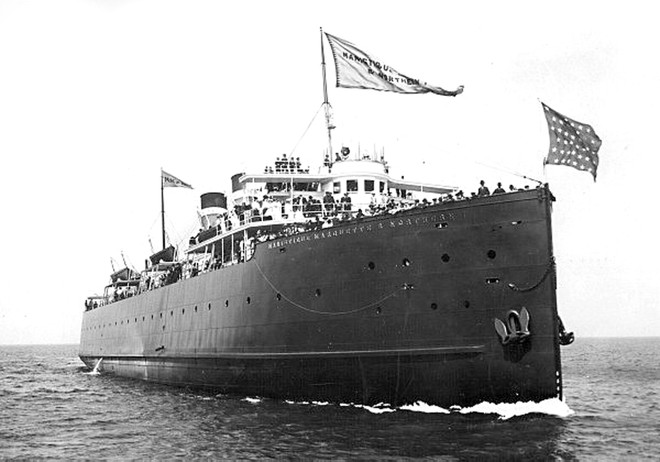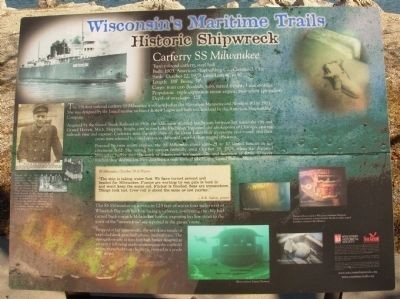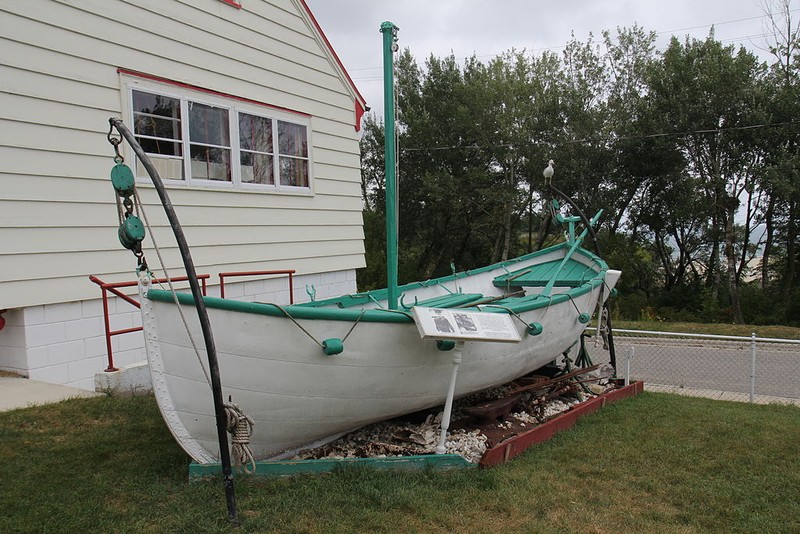SS Milwaukee Shipwreck Historic Marker
Introduction
Text-to-speech Audio
Images
The S.S. Milwaukee

Carferry SS Milwaukee Marker

The lifeboat found near Holland, Michigan with four dead occupants

Backstory and Context
Text-to-speech Audio
Estimates from the Michigan Shipwreck Association show that, since the late 1600s, over 6,000 ships have sunk the floors of the Great Lakes. Other historians claim that this number reaches upwards of 25,000 shipwrecks. Lake Michigan in particular is infamous for its violent gales blowing from the north, causing thousands of disastrous shipwrecks.
One such storm on October 22, 1929, which was called by the Milwaukee Journal as “the greatest freshwater blow in sixteen years,” caused winds in excess of 50 miles per hour as well as driving waves up to 20 feet high.
The storm caused millions in damage around Lake Michigan as well as the loss of several ships, including the SS Milwaukee carferry a few miles off the coast from Whitefish Bay, north of Milwaukee. The sinking of the SS Milwaukee, though not as devastating to the city of Milwaukee as the sinking of Lady Elgin in 1860, it resulted in 52 deaths and it remains as one of the most prolific shipwrecks in Milwaukee history.
The SS Milwaukee was built in 1902 by the American Ship Building Company and launched that same year under the ownership of the Manistique-Marquette & Northern Railroad Company. Under its first ownership, it was named the Manistique-Marquette & Northern No. 1 until 1909, when the Grand Trunk Milwaukee Car Ferry Company bought the ship and renamed it the Milwaukee.
The 338-foot railroad carferry featured twin steam engines, and could shuttle between 25 and 30 freight cars between Milwaukee and Grand Haven, Michigan. Thus, being able to bypass the railroad choking point at Chicago, the Milwaukee saved both time and expenses by shipping the freight cars directly to Michigan, and up until October 1929, the Milwaukee served her owners faithfully.
During the storm on October 22nd, Captain Robert McKay—known by nicknames such as “Captain Bob,” Robert “Heavy Weather” McKay, or Robert “Bad Weather Bob” McKay—had braved the storm that morning crossing from Grand Haven to Milwaukee. Sitting in the Milwaukee dock on the northern end of the Kinnickinnic River, while hail and northeastern (a nor’easter) winds grew in force, dockworkers loaded the Milwaukee. The storm intensified, and two crew members didn’t even bother heading to the dock, claiming that McKay, despite his reputation, would never trek into such dangerous conditions.
A little past 3 p.m., the Milwaukee crew aboard the ship listened in amazement as the departure whistle blared across the dock. Soon after, the Milwaukee slowly pushed off with its 52 crew members and over $100,000 in cargo, including 27 fully loaded train cars packed with automobiles, bathtubs, cheese, and more. While the ship was still in sight, witnesses observed the ship tossing violently on the waves. Three miles offshore, the Milwaukee passed the U.S. Coast Guard Lightship 95, an anchored ship serving as a lighthouse. The log from the lightship described how the Milwaukee was “pitching and rolling heavily.”1
At about 3:45 pm, the Milwaukee disappeared in the rain, mist, and water and was never seen in operation again. Following this sighting, the storms across Lake Michigan nearly paralleled the Great Lakes Storm of 1913, and it was known as one of the most tempestuous in Lake Michigan history.
The next morning, the papers reported millions in damage along the Lake’s shore, five ships that were immediately known to be lost, and, in Milwaukee, how much of the breakwater concrete had dropped into the lakebed. Nevertheless, long overdue ships stumbled into the Milwaukee port, and even the Grand Trunk Railroad Fleet (which owned the Milwaukee) waited eagerly for McKay’s reputation to prove true. One of the owners said during this time that “Capt. McKay is familiar with every nook and cove on Lake Michigan and he very likely has found one in which to ride out the storm.”
Two days later, on October 24th, the Milwaukee was 36 hours overdue and no sights of the vessel came forth until the unfortunate sighting made by the S.S. Cetus off the coast of Kenosha. Found floating in the water were three men strapped in Milwaukee life vests. Two more bodies were found south near Chicago. The following Saturday, amidst pieces of wreckage, a lifeboat showed up carrying four frigid bodies.
52 men lost their lives on the Milwaukee, including McKay, and only nine were ever recovered. Two notes, however, were found.
The first note in a waterproof case read, “The ship is making water fast…We have turned around and headed for Milwaukee…Seas are tremendous. Things look bad. Crew roll is about the same as the last payday.”
Other note, found in a bottle, read, “This is the worst storm I have ever seen. Can't stay up much longer. Hole in side of boat.”
Later examinations of the wreckage, off the coast of Whitefish Bay in 1972, concluded with fair certainty that the cause of the wreckage was failed wheel locks on the railroad cars, which in the undulating waters caused several cars to slam into the starboard side and punch a hole in the storm gate. Abandon ship orders came far too late, with water rushing in, to save the men.2
Cite This Entry
Admin, Clio. "SS Milwaukee Shipwreck Historic Marker." Clio: Your Guide to History. October 12, 2015. Accessed September 19, 2025. https://theclio.com/entry/18929

